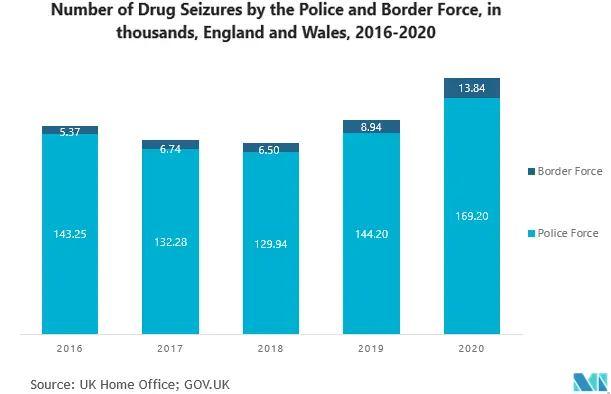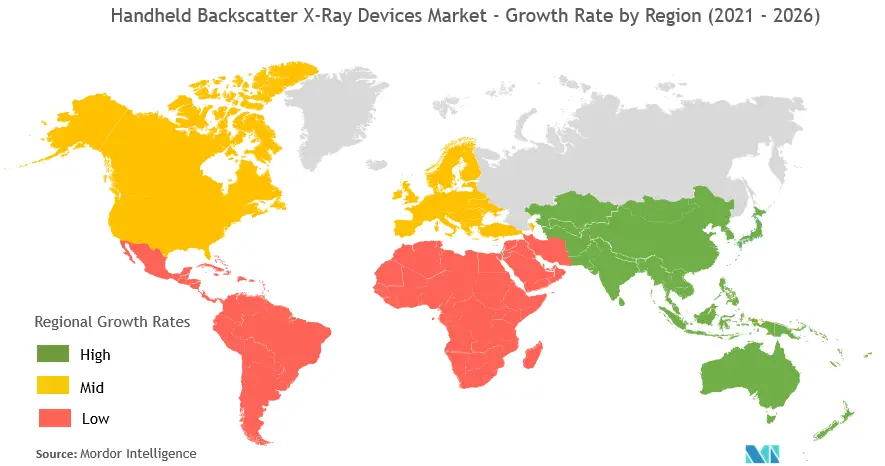Market Trends of Handheld Backscatter X-Ray Devices Industry
This section covers the major market trends shaping the Handheld Backscatter X-Ray Devices Market according to our research experts:
Customs and Border Protection is Expected to Grow Significantly
- The customs and border protection (CBP) organizations are prominent end users of handheld backscatter X-ray devices. Given the scale of the illicit occurrences, the North American region exhibits robust backscatter technology deployments specific to the application. According to the United States CBP, total enforcement actions held by the agency in fiscal year 2019 were 1,148,024. In FY 2020, about USD 93.3 million worth of Narcotic drugs seized from the borders, increasing from USD 68.879 million in the previous year.
- The occurrences of illicit trading of currency, drugs, explosives, arms, ammunition, and endangered species specimens, among other materials, are increasing globally. Hence, it is imperative to look out for unreachable areas, for scanning or scrutinizing the vehicles, to stop such trading. Handheld backscatter X-ray devices play a vital role in identifying these vehicles to prevent these trades and improve national security.
- CBP's biggest challenge is the sheer volume of traffic, which made it impossible to inspect every vehicle. This made them rely on technology to scrutinize and inspect the vehicles. San Ysidro, one of the busiest land border crossings in the Western Hemisphere, roughly has 70,000 vehicle passengers travel northbound from Mexico into the United States almost every day. A typical officer at the border has less than 20 seconds to scrutinize a vehicle and determine whether to let it through or subject it to additional secondary screening.
- The CBP agents performed approximately 6 million non-intrusive inspection (NII) scans in FY 2020 that directly led to the seizure of 216,203 pounds of drugs, USD 3 million in undeclared currency, 1,655 guns, and over 4,500 unauthorized migrants being transported illegally in cargo trucks, since October 2020. The robust adoption of NII is leading to the growth of the market.
- Further, according to the Drug Enforcement Administration (DEA), most of fentanyl, heroin, and methamphetamine are trafficked across the Southwest border into the United States. However, about 2% of all the private passenger vehicles and 16% of commercial vehicles are scanned at land borders.

North America Contributes to Hold a Significant Market Share
- The region holds the highest share of the market, as it houses the majority of the manufacturers, such as Rapiscan and Viken Detection. These companies have developed proprietary methods of their own for developing a handheld backscatter X-ray device.
- Law enforcement and cross-border protection are significant users/adopters of this device. In line with the propensity to adopt, vendors in the region have been increasingly active. For instance, in 2020, Viken introduced its VALOR initiative, which offers free or at-cost refurbished HBI-120 handheld X-ray imagers to local, underfunded police departments. The company aims to reduce/combat preliminary issues that local police faces during an opioid response.
- In early 2020, United States Customs and Border Protection Agency (CBPA) announced its plans to install and test several X-ray imaging systems at ports alongside the southern border. The systems are expected to provide officers and agents with a clearer view of what is crossing the border and easy detection of drugs, weapons, and cash to disrupt transnational criminal networks.
- As part of the Passenger Protect Program, Canada aims to allot CAD 13.3 million to work with partnering departments (Public Safety and Transport Canada) to deliver a Centralized Screening solution to support the enhanced program. In 2020, Canada Border Services Agency (CBSA) invested heavily in sniffer dogs and X-ray machines to catch gun smugglers to its borders. Additionally, training based on new equipment is being conducted.
- Recently, Rapiscan Systems Inc. reported that its handheld backscatter X-ray device MINI Z helped the United States law enforcement to detect 409 lbs. of marijuana concealed in a fake mattress. In June 2021, Viken Detection, provider of x-ray imaging and analytical devices, announced that its channel partner, Federal Resources, awarded the company a USD 2.5 million contract from the US Drug Enforcement Administration (DEA) for Viken Detection’s NIGHTHAWK-HBI handheld x-ray imager.


